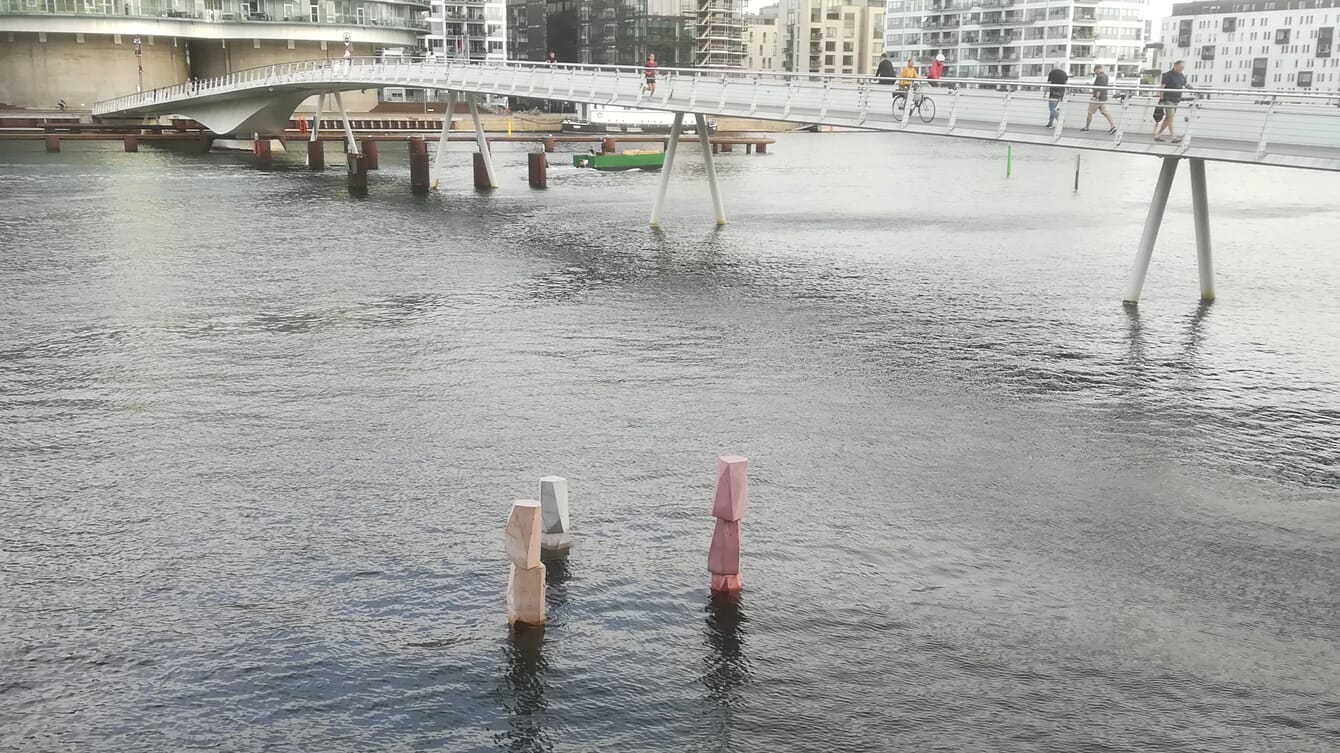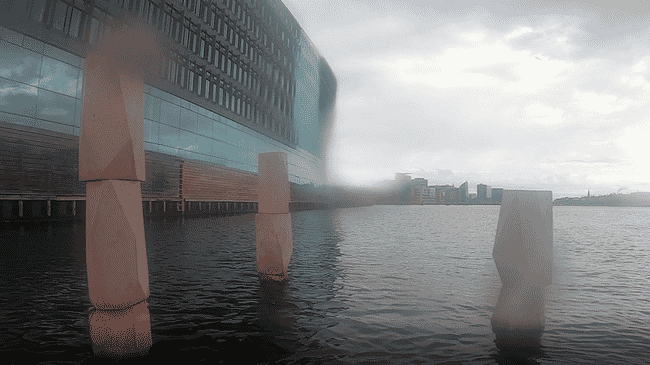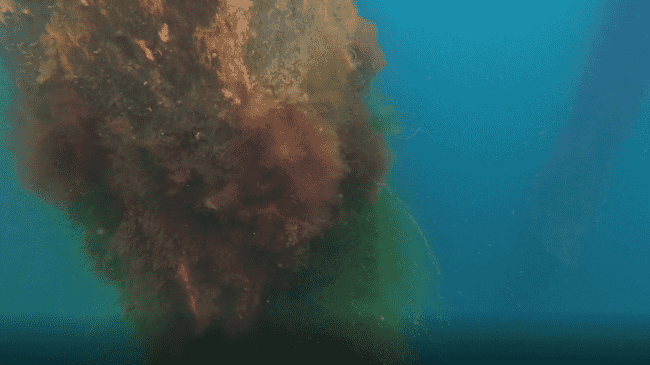
These concrete sculptures are filled with crevices that will eventually become a habitat for seaweed and fish
When you cycle over the Bryggebroen at Fisketorvet, you see three concrete sculptures sticking up above the water surface in Copenhagen's inner harbour. But it is actually only when you get under the water that the work of art comes to life. Here you can see that the sculptures are filled with crevices that will eventually become a habitat for seaweed and fish.
The project is called “Super Reef” and aims to re-establish 55 square kilometers of reef off the Danish coast. Behind the work is the international artist group Superflex, which in an unconventional collaboration with, among others, DTU is investigating whether it is possible to create a stone reef from a newly developed concrete. The expectation is that the construction industry can use the experience for future coastal protection projects, bridges, tunnels and offshore wind farms, which in practice function as rock reefs for seaweed and animals. It must help to increase biodiversity in the sea.
"The ocean's ecosystems are under pressure due to climate change, overfishing, degradation of reefs and far too many nutrients from agriculture and settlements. It is therefore necessary to research innovative materials that can promote biodiversity in the sea. In the long term, we hope that the major infrastructure projects of the future will not only be designed to produce green energy and develop durable climate protections – but also to contribute to strengthening life in the oceans," says Wolfgang Kunther, materials researcher at DTU Sustain.

Denmark removed many of its natural rock reefs as it industrialised
Art and sustainability
The re-establishment of the Danish rock reefs is necessary because over the past 100 years 8.3 million have been removed. Cubic meters of stone have been moved to expand Danish ports and produce concrete. According to a study from DTU Aqua, this corresponds to the removal of 55 square kilometres of habitat for animals and plants – an area slightly smaller than Fanø. When the stones disappear, there are no hiding places for marine animals and places where seaweed and mussels can attach themselves. And if the seaweed disappears, there won't be a rich life of small animals and fish either.
To focus on the lost rock reefs, Superflex has set out to build a kind of underwater habitat for fish. The project functions both as a home for sea animals, a scientific experiment and a work of art. In 2021, Crown Prince Frederik inaugurated the work. In the same year, the artists received the Crown Prince Couple's Culture Prize for using art to put important topics such as sustainability, the lives of other species and climate challenges into debate both here in the country and internationally.
"The work is not just a restoration project - we are also interested in developing new ways of building in the future with a focus on the needs of other species. It is a huge effort that we cannot do alone - but through partnerships and collaborations we can achieve great things," says Malene Natascha Ratcliffe, director of Superflex.
Cement absorbs CO2
The collaboration between Superflex and DTU began when the artist group contacted Wolfgang Kunther to hear about his ideas for using concrete in artificial rock reefs. This led to an inquiry from the development company By & Havn, who asked if DTU would cast, analyse and test concrete elements for the artwork.
On a daily basis, Wolfgang Kunther researches how cement and water act as binders in concrete and react to the surrounding environment and living organisms. Therefore, he knows that there are many advantages to using concrete in the sea. One of the advantages is that concrete is a material that is easy to work with. You can change the composition of cement, change the texture and size and create smooth and raw concrete barriers that may provide ideal living conditions for fish and seaweed.

Superflex has set out to build an underwater habitat for fish, a scientific experiment and a work of art
Another advantage is that concrete actually not only releases CO2 in the manufacturing process and during heating – it also absorbs CO2 . Some call it a sponge effect because the concrete absorbs CO2 like a sponge. The effect is due to a slow process which occurs when the cement solidifies and reacts with the CO2 found in the atmosphere and in the sea. This creates the same type of lime that forms in deposits in the bathroom.
The coating also has the advantage that it creates a natural breeding ground for marine animals, because it resembles coral reefs and seashells. And then there is the matter of longevity.
"In the vast majority of concrete structures that are used for maritime infrastructure projects, concrete is used together with steel reinforcement. But when reinforced concrete is affected by seawater, the reinforcing steel begins to rust – the question is just when. With the type of concrete structure we are testing, we do not expect the use of steel to be necessary. This means that the service life is longer than traditional concrete structures in seawater. It has a big environmental advantage," says Wolfgang Kunther.

It appears that several marine species are attracted to pink concrete
Pink and brown concrete
He recently received the first concrete samples from the artwork. Together with his research group, he is now investigating how the seawater affects the reef installation and whether mineral transformations other than lime occur. The group is also investigating whether it is cheaper and more durable to use concrete reefs rather than imported natural stone, which is traditionally used.
The researchers are testing three different concrete variants, which they have cast in DTU's concrete foundry. One concrete has a pigment added that colours the artificial reef pink, which, according to Superflex, is the favourite colour of several organisms. Another concrete consists of cement added with recycled raw materials from brick productions. It gives a brown concrete. In the third concrete, the researchers partially replace cement with Danish clay that is baked at high heat, creating an orange colour in this case. In addition, it is also being investigated whether concrete from other projects can be reused.
At the same time, marine scientists from DTU Aqua are working to find out how well stone reefs and artificial concrete reefs work in relation to fish – whether there will be many more fish and which fish species will appear at the new type of concrete reef. The questions are answered with the help of underwater cameras, which provide a unique insight into life at the seabed, before and after artificial rock reefs are established. This enables the researchers to compare the measurements and document which positive effects the artificial rock reefs have.
"In the past, ports were often associated with polluting industry, but now the water is so clean that you can swim in many ports. It's a fantastic development for a lot of bathers, but it's also a fantastic development for marine life. This means that the fish can come back to our ports, but often they can be helped along the way in various ways," says senior researcher Jon C Svendsen.
"This is a completely new way of looking at concrete structures. Both when we talk about biodiversity and concrete development. We do not cast standard materials. Therefore, we must ensure that the materials last. We need to know what happens if we replace part of our known concrete with something new. Especially if we are talking about large infrastructure projects that must last for 100 years without major repair interventions. In that way, you can say that we are pioneers.”
The artwork in Copenhagen's inner harbour can be seen until the summer of 2023.




